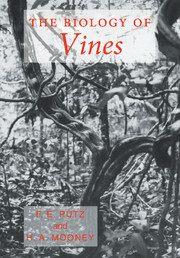Book contents
- Frontmatter
- Contents
- List of contributors
- Foreword
- Preface
- Acknowledgements
- I INTRODUCTION
- II CLIMBING MECHANICS AND STEM FORM
- III VINE PHYSIOLOGY AND DEVELOPMENT
- 5 Water flux and xylem structure in vines
- 6 Reserve economy of vines
- 7 Photosynthesis and gas exchange of vines
- 8 Heteroblastic development in vines
- 9 Physiological ecology of mesic, temperate woody vines
- 10 Secondary compounds in vines with an emphasis on those with defensive functions
- IV COMMUNITY ECOLOGY OF VINES
- V ECONOMIC IMPORTANCE OF VINES
- Taxonomic index
- General index
10 - Secondary compounds in vines with an emphasis on those with defensive functions
Published online by Cambridge University Press: 05 November 2011
- Frontmatter
- Contents
- List of contributors
- Foreword
- Preface
- Acknowledgements
- I INTRODUCTION
- II CLIMBING MECHANICS AND STEM FORM
- III VINE PHYSIOLOGY AND DEVELOPMENT
- 5 Water flux and xylem structure in vines
- 6 Reserve economy of vines
- 7 Photosynthesis and gas exchange of vines
- 8 Heteroblastic development in vines
- 9 Physiological ecology of mesic, temperate woody vines
- 10 Secondary compounds in vines with an emphasis on those with defensive functions
- IV COMMUNITY ECOLOGY OF VINES
- V ECONOMIC IMPORTANCE OF VINES
- Taxonomic index
- General index
Summary
Introduction
Although the distinction between primary and secondary compounds in plants is imprecise and may on occasions appear arbitrary., the two terms effectively group compounds by both structure and role in plant biochemistry. Primary compounds include sugars, fats, protein amino acids, purines and pyrimidines, which are involved in essential cellular biochemical processes. However, plants also contain many thousand so-called secondary compounds which do not appear to be involved in these processes. The detailed structure and function of many of these is still uncertain, but it is generally accepted that their main roles are the selective deterrence or attraction of various classes of herbivore or pollinator (Bate-Smith, 1972; Rhoades, 1983). Such roles are often suggested, in the absence of other evidence, by a distinctive taste or smell. Other compounds such as the phytoalexins are involved in defenses induced by trauma, still others are precursors for biochemical processes within plants. The development of current theories of secondary metabolism in plants is lucidly reviewed by Haslam (1986). Even when a particular compound is known to be present, there may be large quantitive variations, depending on the part or individual sampled, location, age, season, climate, recent herbivory, and even time of day (McKey, 1974; Swain, 1977; Kingsbury, 1980).
After a brief introduction to the role of secondary compounds in plant defence, we will give examples of the more abundant and well-documented classes of secondary compounds found in vines, particularly those which are known to deter herbivores, comparing where possible their distribution in vines and other life forms.
- Type
- Chapter
- Information
- The Biology of Vines , pp. 287 - 310Publisher: Cambridge University PressPrint publication year: 1992
- 2
- Cited by

